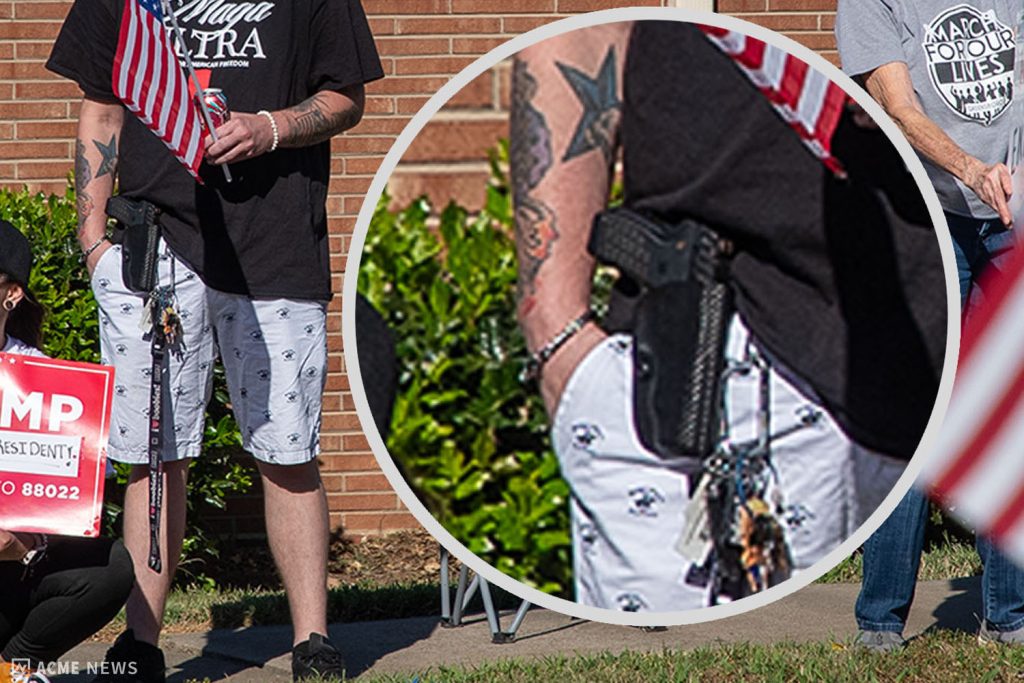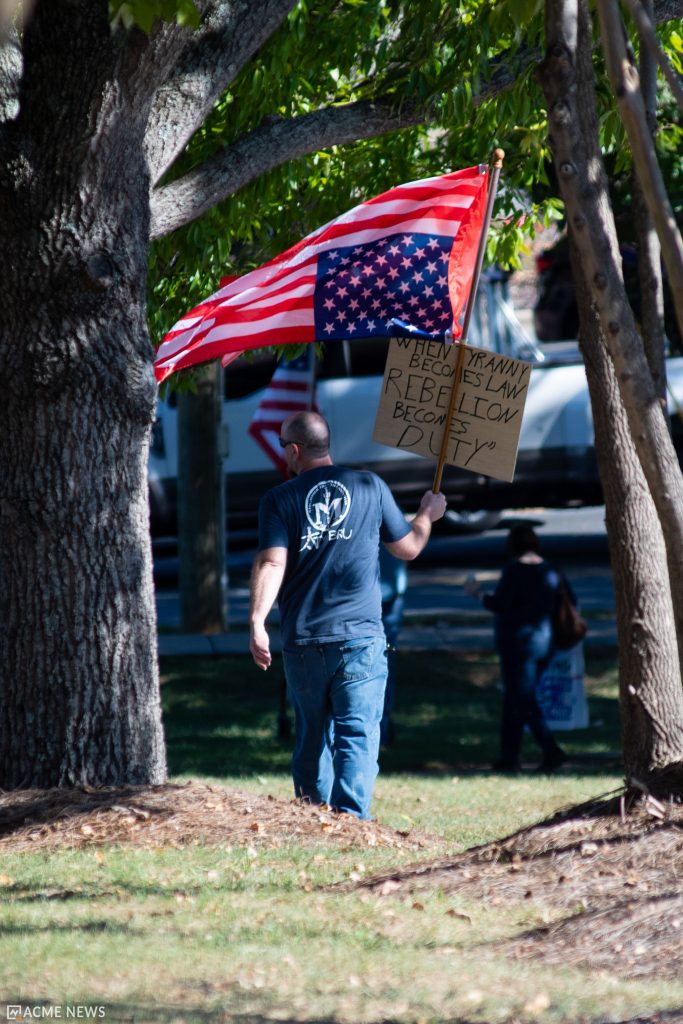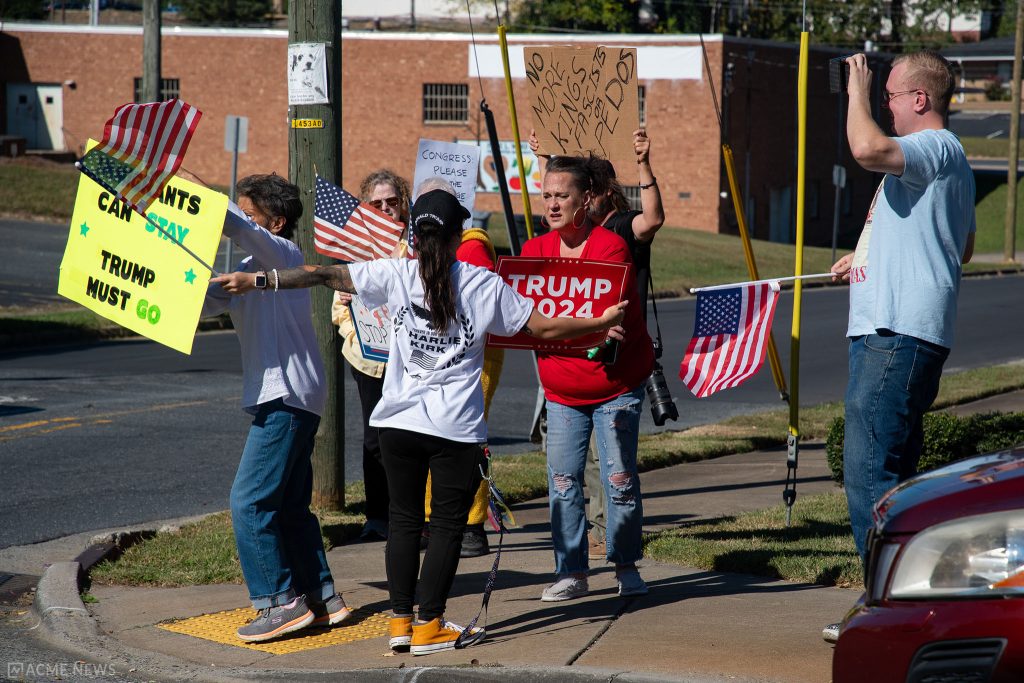
ASHEBORO, N.C. (ACME NEWS) — On Saturday, individuals gathered in Asheboro as part of the nationwide “No Kings” protest. While the demonstration remained peaceful, questions have emerged about the Asheboro Police Department’s response to an individual who arrived openly armed — raising questions about how state weapons laws apply to public demonstrations.
Saturday afternoon, roughly 150 people lined the sidewalks in front of the Randolph County Courthouse as part of a nationwide series of “No Kings” protests focused on concerns about government overreach and constitutional rights. Organizers described the gathering as peaceful and nonpartisan.

Midway through the two-hour protest, participants said a man arrived openly carrying a holstered firearm and stood near a counterprotester already in the area. At least two protesters alerted a nearby officer who had stopped at a traffic light.
Witnesses said the officer pulled into a nearby parking lot but left without taking any action. The armed individual later walked away without incident but remained in the vicinity for a short time.
After the event, several protesters sent letters and emails to the police chief, mayor, and city council, asking why the officer did not respond. On Monday evening, Asheboro Police Chief Robbie Brown confirmed the department had been aware of the armed individual and issued a statement explaining the officer’s actions.
Chief Brown said officers are trained to balance safety, discretion, and de-escalation. Saying that the officer on scene reached out to his supervisors and monitored the situation but saw “no imminent threat that warranted shortening the evaluation and decision-making process.”
“To the maximum extent possible, the Asheboro Police Department strives to enable individuals to safely assemble and exercise their rights,” he said, adding that using “time and distance in the interest of promoting public safety” can sometimes be the best approach.
Jill Painter, one of the organizers, told reporters that day that the group discourages any weapons at its events. “Our official stance is not to bring any weapons or anything illegal,” she said. “We’re not out here to get into a debate or a fight — just to celebrate the freedoms we have and let people know they’re not alone.”
Several protesters said that the presence of a visible firearm at a protest was unsettling. One protester who read the department’s statement Tuesday afternoon told Acme News she was disappointed by the lack of police presence or response and frustrated by what she described as growing hostility toward activists.
“Someone with a gun can become a threat in the blink of an eye,” she said, asking not to be named to avoid retaliation from what she called right-wing agitators. “I’m pro-gun, but when someone shows up armed at a peaceful protest because they don’t like the message, it makes me question their motives. You don’t need a gun to talk to people.”

Questions about the law
Saturday’s incident raised questions about how North Carolina law treats firearms at protests. While North Carolina law allows the open carry of firearms in most public places, there are restrictions. Under N.C. General Statute §14-277.2, it is a Class 1 misdemeanor for any person “participating in, affiliated with, or present as a spectator at a parade, picket line, or demonstration” on public property to “possess or have immediate access to a dangerous weapon.” While the law appears straightforward, it does not define what qualifies as a “demonstration.”
Legal scholars at the University of North Carolina’s School of Government say that omission has long made enforcement inconsistent. In a 2020 analysis titled “Demonstrating With Guns,” UNC criminal law specialist Jonathan Holbrook wrote that although the statute clearly prohibits firearms at parades or demonstrations on public property, “it does not define the terms parade, picket line, or demonstration, and there are no appellate cases interpreting and applying this statute.”
Holbrook noted that determining whether an armed person is a “participant,” “affiliate,” or merely a “spectator” at a demonstration can be highly subjective, leaving officers and prosecutors with broad discretion. “A prosecution under this statute seems possible,” he wrote, “but meeting the state’s burden of proof in any given case may be challenging.”
In 2020, Greensboro police charged six individuals under the “Weapons at Parades Ect” statute after they were arrested for bringing weapons to a protest. Of the four cases located in court records, one was dismissed through a deferred-prosecution agreement in 2021, another was dropped after the defendant was indicted on unrelated federal gun charges, and two others were later dismissed by prosecutors. Records for the remaining two defendants could not be located.
The ambiguity in the law leaves law enforcement agencies balancing enforcement, public safety, and constitutional rights — while also creating uncertainty for individuals seeking to lawfully exercise open-carry rights in or around public demonstrations.
Asheboro Police Department – Full Statement
Thank you for sharing your observations and concerns about the events that transpired on Saturday, October 18, 2025. You correctly pointed to G.S. 14-277.2 as a section of the criminal law relevant to the event in question.
I need to emphasize that officers evaluating a situation are instructed to look at multiple sections of the criminal law and at the big picture when evaluating the facts on the ground. As you have seen, volatile situations can erupt at events where individuals express different opinions and exercise different rights.
Officers cannot get tunnel vision. In addition to determining whether there is probable cause to make an arrest, officers must maintain a situational awareness as to the steps that are most likely to advance our agency’s public safety goals.
To the maximum extent possible, the Asheboro Police Department strives to enable individuals to safely assemble and exercise their rights. To do this, in addition to considering the viability of filing criminal charges, we also try to de-escalate volatile situations and prevent harm from occurring. One method for de-escalating a situation is to slow things down and use time and distance in the interest of promoting public safety.
You are correct, on Saturday, October the 18th, an Asheboro police officer was made aware of an individual standing on a sidewalk with a holstered firearm. In response, the officer began actively observing the individual and evaluating the situation.
While not readily apparent to bystanders, the officer engaged his supervisors about what had been reported to him and what he had personally observed. The officer did not see an imminent threat that warranted shortening the evaluation and decision-making process. Before overt enforcement action was taken, the individual with the holstered firearm left the area without further incident.
I hope this information is helpful in understanding what transpired and how the city police department attempts to make it possible for events to be safely held and without unnecessarily elevating tensions. Please know that I appreciate your email message. The questions and concerns you shared with me are helpful to my continuing efforts to improve the agency’s evaluation and response approach to public events.
###

